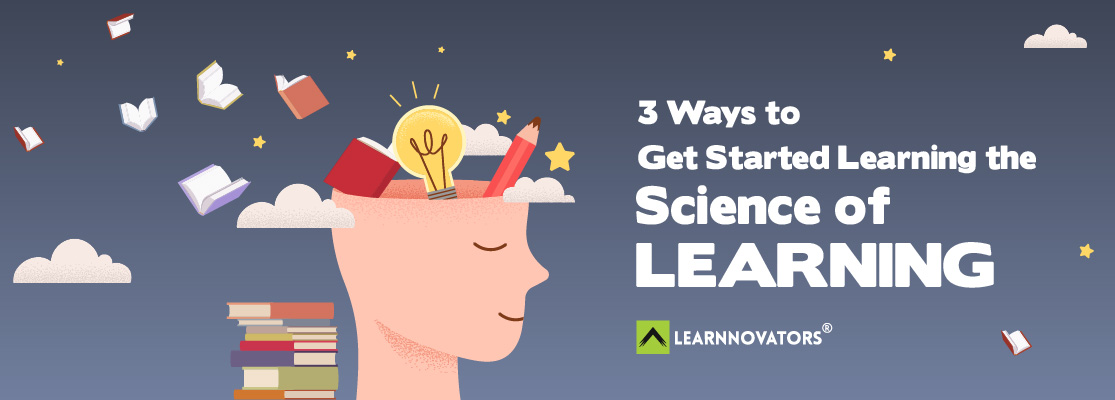Human beings are creatures of emotion. That’s why we decide with our gut and then use logic to justify our decisions. That’s also why it takes well-told stories, and not data or logic, to get people to see differently. While this gut-centered approach might be okay for personal decisions, those of us in learning design would do well to take the help of science to inform our work. We have to, if we want to do justice to learners and the business at large.
As a learning practitioner, irrespective of where we are on the experience spectrum, it can be really hard to understand and keep up with the science. This is especially true if we don’t come from a scientific background. There are the pressures of day-to-day work, and if we are even a little bit curious (which we should be!), the onslaught of information that’s available for us to consume from a million sources can quickly overwhelm.
Getting a formal degree in instructional design might sound like a distant dream. However, there are things we can do immediately to inform ourselves better and start incorporating evidence-informed principles into our practice. Here are a few practical ways to help you get started.
1. Read books on the subject
While scientists are marvelous at, well, the scientific stuff, presenting their findings in an easy-to-read style is not exactly their strength. Luckily for us, there are a few books that can help us get started on this journey. Here are a few of them.
- eLearning & the Science of Instruction, by Ruth Colvin Clark & Richard Mayer
- Learning Science for Instructional Designers: From Cognition to Application, by Clark Quinn
- Design for How People Learn, by Julie Dirksen
- Write and Organize for Deeper Learning, by Patti Shank
- Map It: The hands-on guide to strategic training design, by Cathy Moore
There are several others, but these serve as a wonderful starting point for someone who wants to dip their toes into the subject without drowning in a mountain of research papers.
2. Follow research translators
In case you weren’t aware, yes, this is a legitimate profession that exists. And in our field, there are a handful of research translators who do the difficult and grinding work of poring over all the academic material and simplifying it for practitioners to use. We should thank them every day.
In the words of Will Thalheimer, one of the most prolific research translators in learning, these “…are people who read research articles from scientific refereed journals and distill the wisdom from those articles into practical recommendations for practitioners… Research translators add value because they bridge the gap between the worlds of research and practice — between groups who speak different languages.”
So, here are four that I follow.
Again, there are several others, but these are great to start with. You can connect with them on LinkedIn, and follow their updates on Twitter / Facebook, just to get a handle on what they are talking about.
3. Befriend Google Scholar
If you want to get up to speed on the science behind our profession, there is no escaping the actual reading of scientific articles. But once you get started, trust me, this can become extremely interesting.
Google Scholar is a free academic search engine that works pretty much like regular Google search. The only difference is that instead of searching the whole web, it only searches academic materials. This means you can use it to look for reliable sources of information instead of stuff that anyone can put out on the internet.
When you do decide to go down this route, here are a few ways to get the most out of Google Scholar:
- Free vs. Paid Articles: One point to note is that some of the content you see in the search results may not be freely available, but Google Search tries to find free alternative copies of such articles. In such cases, you will see a link to the right of the entry that will take you to the free version.
- All x versions: In case an article you find interesting is not available for free, you can click “All x versions” below the link to the article. This will bring up a list of sources, and you might find a free version.
- Cited by: Even though Google Scholar searches only academic material, your search would still yield all sorts of results. A quick way to understand the credibility (and level of acceptance) of a source is to check the “Cited by” link below the source. This tells you the number of times that others in the scientific community have referred to and cited this material. The higher the number of citations, the more credible your source probably is. Click on this “Cited by” link to follow the other content and get a sense of what those other articles are saying.
- Related articles: If you like a source, and would like to get a better sense of the broader topic, you can use the “Related articles” link.
- The star symbol: Once you have identified a source that you think is relevant, you can save it to your library for later access.
If you’re feeling overwhelmed thinking about how much there is to learn and absorb, remember that even someone who is a master in the field needs to constantly keep themselves updated on the newest scientific and technological advances. In fact, masters are constantly reflecting on their practice, and are always open to feedback and criticism.
So, keep in mind that mastery is a journey and not a destination. Enjoy the journey while you’re there.
Written by Srividya Kumar, Co-Founder @ Learnnovators






